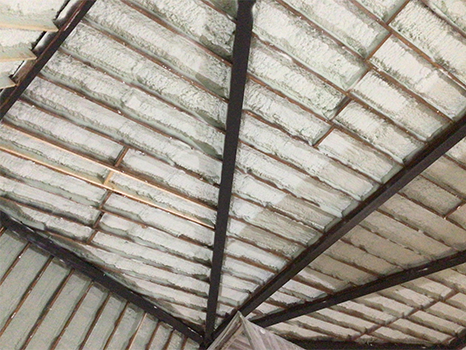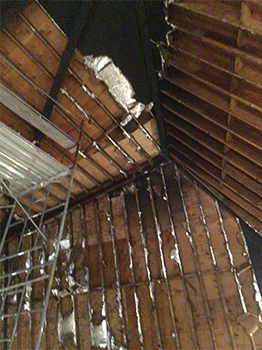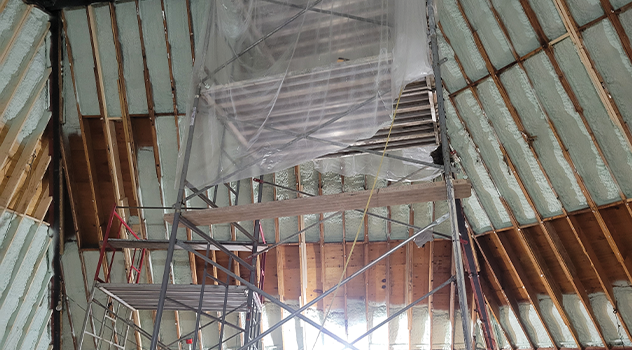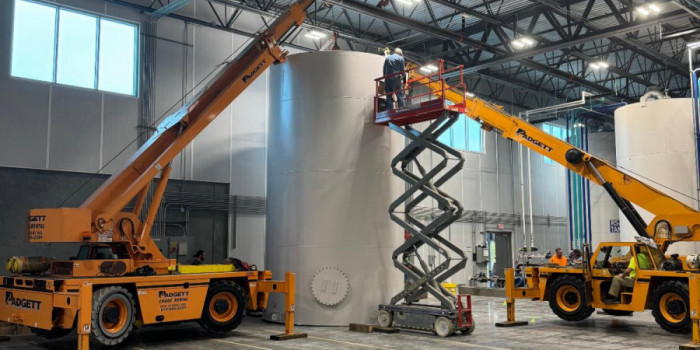The Star of the Show


SPRAY FOAM MAGAZINE – On a quiet Monday afternoon in January 2023, Ohio’s Youngstown State University (YSU) suffered a fire at Ward Beecher Hall, the same building that houses the campus’s beloved planetarium. Fortunately, all students, faculty, and staff made it out unscathed if a little shaken, but the same good fortune did not extend to the building itself. Post-fire investigations revealed the extent of the damage, and indicated that the entire roof would need rebuilding. Substantial sections of the building’s walls and interior components would also need replacing, including the planetarium’s dome.
At the time, the fire was a major blow to the morale on YSU’s campus, but now, nearly two years later, the building and the planetarium it contains have been transformed for the better. As harrowing as the fire was, it gave YSU the chance to make several updates to the building, which was originally built in 1967 and had undergone little structural upgrades since then. While drafting blueprints for the planetarium building’s future, architects included a plan to replace its antiquated fiberglass insulation system with a hefty four- and one-half inch layer of closed-cell spray foam insulation across the entirety of its 3,300 square foot roof deck.
The modernized spray foam insulation system will maintain the building’s internal temperature, keeping it comfortable and consistent year-round. No matter how much heat the planetarium’s lights, projectors, and other equipment emit, the spray foam will ensure the building’s air conditioning doesn’t have to work overtime to compensate.

A completed section of the roof deck after the SPF application. It now has an R-value of R-30, approximately 10 times the old insulation’s R-3
What’s more, the foam will reinforce and protect Ward Beecher Hall’s new roof deck and keep the building in pristine condition so that it can continue holding classes, hosting shows, and sponsoring events for years to come.
In an interview with WKBN, planetarium engineer Curt Spivey praised the positive effect that the new spray foam insulation would have on the building. “What little insulation that was left behind the drywall was maybe R-2 or R-3, now, we have spray foam insulation that’s up to R-30.”

The existing insulation damaged in the fire needed to be removed before the foam could be installed.
YSU hired Youngstown’s own B&B Contractors and Developers to do the brunt of the construction work. B&B was tasked with rebuilding and remediating the damaged roof and walls, while also tearing down and reconstructing a brand-new planetarium dome. B&B was up for the task, so they decided to enlist the help of an insulation subcontractor to ensure the foam insulation was up to par. Anthony Gentile, B&B’s project manager, sought out bids from spray foam companies, and selected a firm from a few states over– Insulation Coatings and Consultants (ICC) from Sherman, New York. Charles Sorce has owned and operated ICC since 1977 and he and his team are experts in spray acoustical and thermal insulation systems.
ICC would use Huntsman Heatlok HFO Pro closed-cell foam for this project, but before ICC could apply the foam, B&B had to finish installing the new roof deck. It was no small task. “First, we’d gutted the entire planetarium and stripped off all the old gypsum and insulation,” Gentile explained. “When that was done, ICC came in and sprayed the closed-cell foam up against the bottom side of the roof sheathing. Then we put up new drywall over top of that.”
A significant portion of the roof deck was brand new and the plywood and wood beams were clean and in mint condition. But even the parts of the roof deck that hadn’t needed a complete rebuild were stripped of all traces of the old fiberglass insulation and gypsum board, leaving a clean surface for the foam to adhere. After receiving notice that the roof deck had passed inspection, Gentile called up ICC to initiate the next phase of the project: the spray foam system’s installation.
A crew of three ICC technicians traveled to Youngstown in April 2024 and knocked out the foam application over the course of four days. The general contractors had already done most of the site prep prior to the ICC team’s arrival at YSU. ICC only needed to lay down plastic sheets to protect the floors underneath where they’d be working. As a courtesy, they also covered the scaffold so it wouldn’t get dirty while they worked. Once the plastic was in place, they were ready to fire up and start spraying.
Using a Graco H-40, the ICC crew applied a four- and one-half inch layer of Huntsman Heatlok HFO Pro closed-cell foam to the entire roof deck. To reach the angled roof’s highest points, they stood on a rolling Baker scaffold. While spraying, they wore Tyvek suits, gloves, and full-face respirators to protect themselves. The ICC technicians methodically filled in each section of the roof sheathing with foam, creating a durable foam layer between each beam.
Huntman’s Heatlok HFO Pro is a notable foam due to its built-in fire-retardant properties, which passed the NFPA’s Standard Fire Test Method. Passing the NFPA’s test means that the foam possesses innate intumescent qualities without the need to apply a separate thermal barrier coating on top of the foam. The foam’s thermal resistance saved ICC a step in the foaming process, and allowed them to finish the job faster and more efficiently. The Huntsman foam served as a one-stop shop, providing the planetarium with superior insulation, plus an air, vapor, and thermal barrier all in a single innovative product.

After finishing the spray foam application and getting approval from B&B, ICC cleaned up the protective plastic and wished the builders good luck on the final phases of construction before heading back to their home base in New York. After the ICC team left, B&B completed the roof deck by adding new drywall atop the smooth foam layer. Once they’d added the drywall and finished the roof deck, it was time for the main event– assembling the planetarium’s new dome.
The dome itself was constructed inside the building, underneath the newly rebuilt roof deck. Essentially, the dome is a separate room within Ward Beecher Hall, a fully-immersive theater where images of the universe are projected all around. The dome itself didn’t receive a coating of foam because it didn’t need any– applying foam to the roof deck above was more than sufficient to maintain the building’s energy efficiency despite the structure’s age and all the equipment housed inside.
By the end of summer 2024, construction crews had begun to wrap up their final projects at Ward Beecher Hall, adding the finishing touches and tying up any loose ends.
“Our contract with YSU is just about finished. I know they have other vendors working directly with the dome equipment, but the construction part is substantially complete. This was our first time working with ICC. They were a great subcontractor for sure.” Gentile said.
Ward Beecher Hall’s January 2023 fire may have initially rattled the YSU community, but everyone involved remained optimistic about the building’s fate. YSU anticipates the planetarium will have a grand reopening in October 2024 and aims to resume regular programming by late 2024 or early 2025. Although it took nearly two long years of careful planning and hard work, the 50-plus year-old planetarium’s future looks out of this world.
For use by SprayFoamMagazine.com & Spray Foam Magazine
Disqus website name not provided.










































